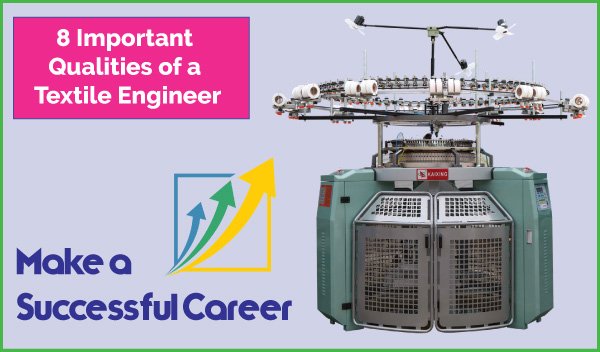What Is Textile Engineering? A Complete Overview
Last updated on January 27th, 2024 at 11:26 am
Textile engineering is a popular engineering field in this modern era. If you do not know much about textile engineering, you can surely realize that you do not know broadly about the textile industry in this current age situation. It is a background condition for you.

Now, this is the time to boost up your knowledge about this vast industry. Here we will describe the definition, sectors of textile engineering, applications, and the importance and scope of textile engineering. We hope this article will help you out with increasing your information store of textile engineering.
Suppose you are at the stage of choosing a career for yourself. In that case, you can select textile engineering and if you are interested in strengthening your perception of the Textile Industry, read this article with some concentration.
What is Textile Engineering?
Textile engineering is formed with two different words: textile and engineering. Textile is a Latin word that refers to texture means to weave. It indicates woven, non-woven, fabric, or cloth. Textile is related to producing any product of textile materials or apparel. Textile manufacturing is a significant industry in the world because clothing is one of our fundamental needs. Now the word engineering came from another Latin word Ingenium, and the primary purpose of engineering is to engage you with science.
Definition of Textile Engineering
“Textile engineering is a type of engineering where with the help of science and math, they produce different fabrics or threads for various varieties of products. Moreover, textile engineers invent necessary machines and appliances for the textile industry.”
Textile engineering is a branch of applied science and technology that deals with the design, production, processing and utilization of textiles.
You may also like: Future of Textile Manufacturing Industries
Sectors of Textile Engineering
Spinning
Spinning is producing fibers or yarn from a massive continuous thread or mass of cotton or wool. In previous decades spinning could be done by hand or charkha. However, in this twenty-first century, you can bring various kinds of machines for sipping. Axo Flow Cleaner M/C, S.R.L.L. Cleaner M/C, Step Cleaner, or Ultra Cleaner M/C are essential instruments for spinning.
Knitting or Weaving
You will get yarn by spinning, then come knitting or weaving. Knitting is a process in which two sets of yarn are bonded to make a fabric. You can produce knitted fabrics from knitting technology. These knitted fabrics are essential for the textile industry. Many modern machines are used for this knitting process, like the Single Jersey Circular knitting machine, Rib Machine, Plain Circular Latch Needle Machine, etc.
Wet Processing or Dyeing
Wet processing or dyeing is a significant sector of textile engineering because, in this process, the fabric mixes with chemicals and color. So, you can get your desirable material. For the industry, dyeing machinery is mainly used. Beaker Dyeing Machine is one of them.
Garments or Apparel
We all know about the Garments or Apparel sector of textile. The clothing industry is known as the Garments area. Garments are included in manufacturing cotton, wool, fur, fiber, and synthetic. The fashion industry is also attached with Garments. In this stylish generation, there are different types of machines used in the area of the garment.
Applications of Textile Engineering
Clothing Sector
Cloth is one of our fundamentals right, and without the textile industry, you cannot produce fiber after that cloth. To run the industrial textile company properly, you must need textile engineers. The people who study textile engineering are called textile engineers.
Health and Personal Protective Equipment
Especially the non-woven fabrics used to generate the medical health equipment like P.P.E., head cover, surgical mask, etc. In 2021 you cannot think about your life without health and personal protective equipment precisely. It is becoming the most valuable application of textile engineering.
Fashion Designing
Nowadays everyone wants to follow the trends of fashion, and fashion comes from your clothing sense firstly. To make stylish clothes, you require the entire quality fabric, and you will get this fabric when the material is produced from the textile industry by the textile engineers.
Textile Sensor
Textile Sensor is an excellent invention by textile engineers. It is a textile-based sensor that empowers a monitoring system to the users with an electrical signal. Many variables work for Textile Sensors: pressure, humidity, temperature, strain, etc. You can get some types of textile sensors. For example, resistive, piezoresistive, and capacitive.
Importance and Scope of Textile Engineering
Textile engineering is responsible for dealing with garments, the fabric is made in the textile industry, and the material is the vital element to make clothes. People think textile engineering is taught to make cloth, but it is a misconception. The truth is textile engineering is taught the basics of textile. How to make fiber from natural products, arrange the fabric, dye the threads, and use various devices and machines for this sector.
An Essential Industry for Every Country
Every human being in this world needs cloth. So, every country has this industry of its own. If any government fails to manufacture fabric for its country, they have to export it from another country. It is the main reason for making it an essential industry. If you become a textile engineer, you will get enough sectors to work with.
Demandable Subject
Textile engineering is a growing and one of the most demandable subjects of the world. So you can find this subject at any of the highly recommended universities of the world so that you can acquire proper knowledge.
Job Opportunities and Promising Career
In textile engineering, you have substantial job opportunities, and you can build a promising career. Garments are crucial for any country. You will get many companies to prove your worth.
What does Textile Engineer do in Textile Engineering?
Basically, textile engineers are responsible for designing the manufacturing process to create clothing or apparel. They also deal with designing machinery that can be used in mills or garments factories for weaving fabrics and yarns into cloth.
Textile engineers work closely with every section of a factory or mill to ensure they’re able to meet their needs. A textile engineer’s job is to make sure that the materials used in manufacturing are able to be produced cost-effectively while maintaining high quality.
They must constantly seek out ways of improving their design process, testing new fabrics and experimenting with different yarns. Any time there is a change in trends or fashion design, textile engineers must be able to adapt quickly in order to keep up.
Qualifications Needs for a Textile Engineer
Textile engineering is considered an advanced profession and you can expect your education requirements to reflect this. It means that you’ll need at least a bachelor’s degree in Science Background. After completed your higher secondary graduations you can get admitted to the Textile Engineering Institute. In sometimes you need to get through the admission test and get admitted into your respective textile colleges or universities to get a degree in Textile Engineering.
Advantages of Working as a Textile Engineer
This career offers many benefits, including being able to work with new materials and technology every day while also having the opportunity to travel frequently for business purposes. Many textiles’ engineers find that they’re constantly learning something new in their field, which makes the career exciting and interesting.
Disadvantages
It can be tough to keep up with trends while also working closely with buyers and designers. So textile engineers must always remain patient and willing to learn new skills. The job may not be for everyone but it’s definitely a good choice for those interested in a career that allows them to constantly grow and learn more about the field.
What are the Salary Expectations of a Textile Engineer?
Textile engineering is becoming an increasingly popular field and salaries can vary based on location, experience level and other factors.
Many entry-level positions will begin around $200 per month while more advanced professionals with years of experience may earn up to $50k per year or more. It varies on the country and company regulations.
Conclusion
Textile engineering is developing day by day, with increasing opportunities, sectors being vast, and applications areas expanding quickly. We hope, after glancing at this article, you get an overview of Textile Engineering.
You may also like: What is Textile? Definition and Meaning
Frequently Asked Questions (FAQ)
What does textile engineer do?
Textile engineers are professionals who specialize in the design, development, and manufacturing of yarns, sewing threads, grey fabrics, dyed fabrics, trims, accessories and different clothing items. Their primary focus is on creating and improving materials and processes related to textiles. They also look after on raw material development, production process optimization, quality control, research and development, environmental and sustainability considerations, product design, testing and analysis and regulatory compliance.
What is an example of textile engineering?
An example of textile engineering is the development of smart textiles, or e-textiles. Smart textiles incorporate electronic components and technology directly into fabrics, providing functionalities beyond traditional textiles. Textile engineers play a key role in designing and producing these innovative materials.
What is the subject of textile engineering?
The subjects of textile engineering in different countries are textile fibre, yarn engineering, fabric engineering, wet engineering, dyes and chemicals, machine design & maintenance, fashion & design, chemical processing of textiles, etc.
What is a textile engineering degree?
A textile engineering degree is an academic program that prepares students for careers in the textile and clothing industry. It provides them with a comprehensive understanding of the principles and technologies involved in the design, manufacturing, and application of textile materials.
What is the salary of a textile engineer in Bangladesh?
Salaries vary based on different factors such as the level of education, experience, location, and the specific industry where the engineer is employed. As a rough estimate, entry-level engineers in Bangladesh may earn a monthly salary ranging from BDT 25,000 to BDT 40,000.




Good
It will be great to be a Textile engineer
My rather long internet look up has at the end of the day been compensated with pleasant insight to talk about with my family and friends.
I’ve bookmarked your site, and I’m adding your RSS feeds to my Google account.